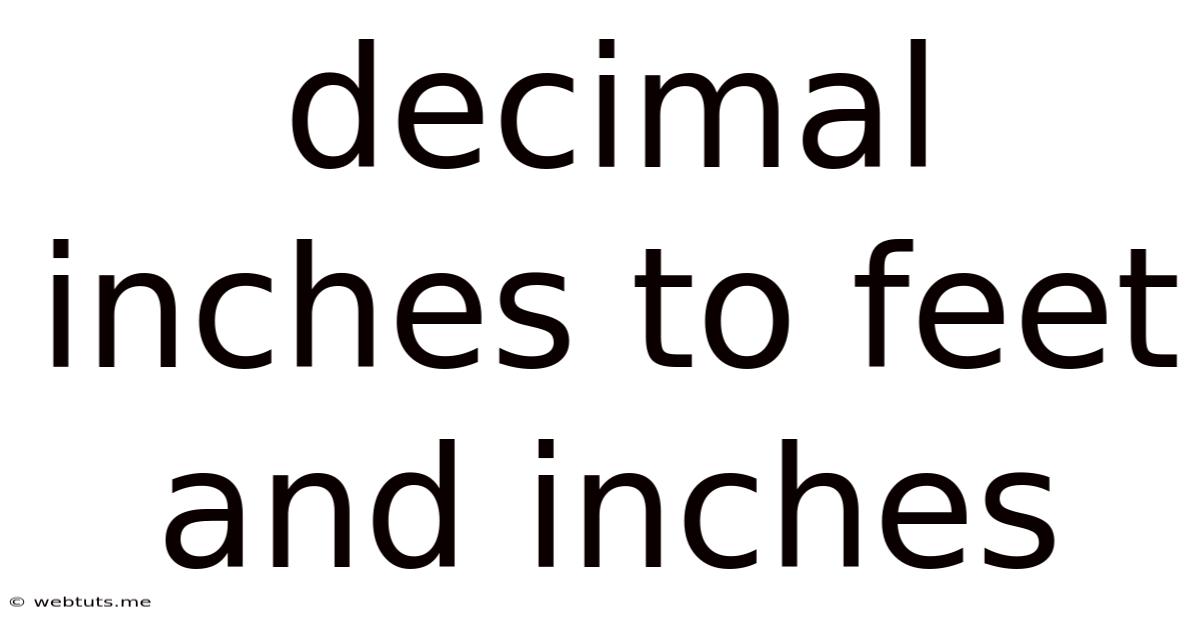Decimal Inches To Feet And Inches
Webtuts
Mar 20, 2025 · 4 min read

Table of Contents
Decimal Inches to Feet and Inches: A Comprehensive Guide
Converting decimal inches to feet and inches is a common task in various fields, from carpentry and construction to engineering and design. Understanding this conversion is crucial for accurate measurements and calculations. This comprehensive guide will walk you through different methods, provide practical examples, and explore tools that can simplify the process. We'll cover everything from the basic arithmetic to utilizing online calculators and spreadsheet functions.
Understanding the Conversion Basics
Before diving into the methods, it's essential to understand the fundamental relationship between inches, feet, and the decimal system.
-
1 foot (ft) = 12 inches (in) This is the cornerstone of our conversion. Remember this key relationship!
-
Decimal inches: These represent fractional parts of an inch using a decimal point (e.g., 12.5 inches, 3.75 inches).
The goal of the conversion is to express a measurement given in decimal inches into a whole number of feet and a remaining number of inches.
Method 1: Manual Calculation (Using Division and Remainder)
This method involves basic arithmetic and is a great way to understand the underlying principles. Let's break it down step-by-step:
1. Divide by 12: Take your decimal inches measurement and divide it by 12 (since there are 12 inches in a foot).
2. Determine the Whole Number: The whole number result from the division represents the number of feet.
3. Find the Remainder: The remainder (the fractional part) of the division represents the remaining inches.
Example:
Let's convert 25.75 inches to feet and inches.
-
25.75 inches / 12 inches/foot = 2.145833 feet
-
Whole number: 2 feet (this is the integer part of the result)
-
Remainder: To find the remaining inches, multiply the decimal part of the result (0.145833) by 12. 0.145833 * 12 ≈ 1.75 inches.
Therefore, 25.75 inches is equal to 2 feet and 1.75 inches.
Method 2: Using Fractions
While decimal inches are common, you might encounter measurements in fractional inches (e.g., 1/2 inch, 3/4 inch). Converting these to decimal inches before applying the division method simplifies the process.
Example:
Convert 3 feet and 5 3/4 inches to decimal inches then to feet and inches.
-
Convert the fraction to a decimal: 3/4 = 0.75
-
Convert to total inches: 3 feet * 12 inches/foot + 5 inches + 0.75 inches = 41.75 inches
-
Now, use Method 1 to convert back: 41.75 inches / 12 inches/foot = 3.479 feet. This gives us 3 feet (the whole number).
-
Find the remainder: 0.479 * 12 inches/foot ≈ 5.75 inches.
Therefore, 3 feet and 5 3/4 inches is equivalent to 3 feet and 5.75 inches (which was our starting point, confirming the conversion accuracy).
Method 3: Utilizing Spreadsheet Software (Excel, Google Sheets)
Spreadsheet software provides built-in functions to simplify this conversion. The QUOTIENT and MOD functions are particularly useful.
-
QUOTIENT(number, divisor): This function returns the integer part of the division. In our case, the 'number' is the decimal inches, and the 'divisor' is 12. This gives you the feet.
-
MOD(number, divisor): This function returns the remainder of the division. This gives you the remaining inches.
Example (Google Sheets):
Let's say cell A1 contains the decimal inches value (e.g., 37.25). In cell B1, enter the formula =QUOTIENT(A1,12) to get the feet. In cell C1, enter the formula =MOD(A1,12) to get the remaining inches.
Method 4: Employing Online Calculators
Numerous online calculators are readily available to perform this conversion. Simply search for "decimal inches to feet and inches converter" and you'll find several options. These calculators usually require you to input the decimal inches value and will instantly provide the equivalent feet and inches.
Practical Applications and Examples
The conversion of decimal inches to feet and inches is crucial in various real-world scenarios:
-
Construction and Carpentry: Precise measurements are vital for accurate cutting of lumber, designing structures, and ensuring proper fitting of components.
-
Engineering and Design: Converting decimal inches to feet and inches is essential for creating accurate blueprints, technical drawings, and manufacturing specifications.
-
Manufacturing: Many manufacturing processes rely on precise measurements in both decimal and imperial units, making conversions necessary.
-
DIY Projects: Whether building furniture, installing flooring, or completing home repairs, accurate measurements are critical for success.
Advanced Considerations and Troubleshooting
-
Rounding: When dealing with remainders, you might need to round the inches to the nearest fraction or decimal place, depending on the required accuracy.
-
Negative Values: If you encounter negative decimal inch values, remember the sign will carry over to the feet and inches result. For instance, -25.75 inches would be -2 feet and -1.75 inches.
-
Significant Figures: Pay attention to the significant figures in your original measurement to avoid introducing unnecessary precision into the converted values.
Conclusion
Converting decimal inches to feet and inches is a fundamental skill with applications across many fields. Mastering the different methods—manual calculation, using fractions, spreadsheet functions, and online calculators—provides flexibility and efficiency. Remember the key relationship of 12 inches per foot, and always double-check your results to ensure accuracy. By understanding these techniques, you can confidently handle measurements and calculations involving decimal inches, contributing to more precise and efficient work in any project.
Latest Posts
Latest Posts
-
One Pound Of Sugar Equals How Many Cups
May 09, 2025
-
120 Days From December 31 2023
May 09, 2025
-
What Is 72 Hours From Friday
May 09, 2025
-
How Many More Days Until December 16th
May 09, 2025
-
What Is 26 Degrees Centigrade In Fahrenheit
May 09, 2025
Related Post
Thank you for visiting our website which covers about Decimal Inches To Feet And Inches . We hope the information provided has been useful to you. Feel free to contact us if you have any questions or need further assistance. See you next time and don't miss to bookmark.